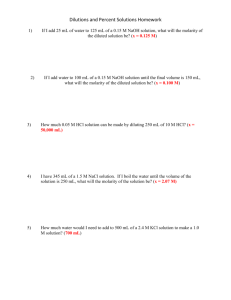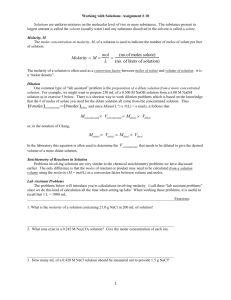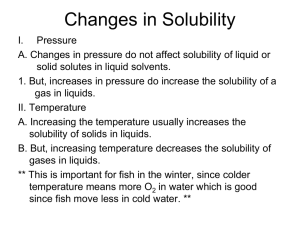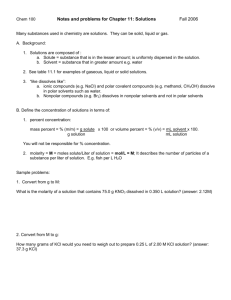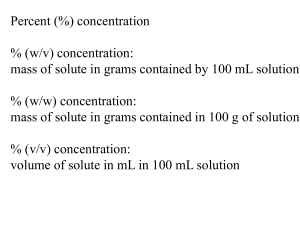Solutions molarity (Homework) - Tutor
advertisement
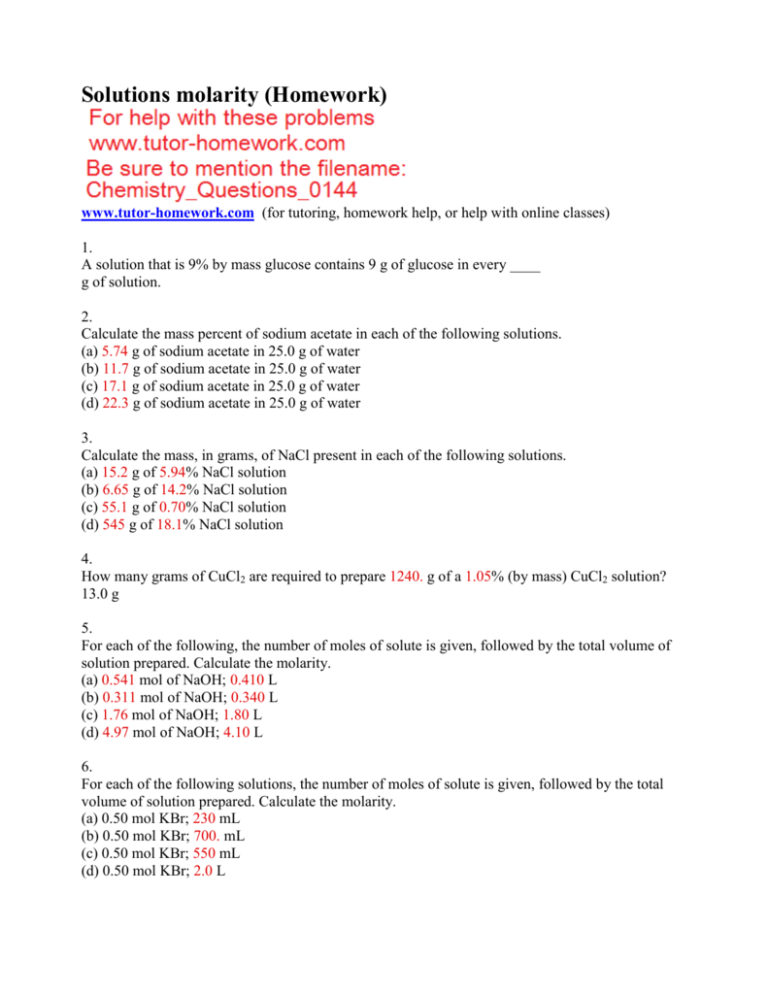
Solutions molarity (Homework) www.tutor-homework.com (for tutoring, homework help, or help with online classes) 1. A solution that is 9% by mass glucose contains 9 g of glucose in every ____ g of solution. 2. Calculate the mass percent of sodium acetate in each of the following solutions. (a) 5.74 g of sodium acetate in 25.0 g of water (b) 11.7 g of sodium acetate in 25.0 g of water (c) 17.1 g of sodium acetate in 25.0 g of water (d) 22.3 g of sodium acetate in 25.0 g of water 3. Calculate the mass, in grams, of NaCl present in each of the following solutions. (a) 15.2 g of 5.94% NaCl solution (b) 6.65 g of 14.2% NaCl solution (c) 55.1 g of 0.70% NaCl solution (d) 545 g of 18.1% NaCl solution 4. How many grams of CuCl2 are required to prepare 1240. g of a 1.05% (by mass) CuCl2 solution? 13.0 g 5. For each of the following, the number of moles of solute is given, followed by the total volume of solution prepared. Calculate the molarity. (a) 0.541 mol of NaOH; 0.410 L (b) 0.311 mol of NaOH; 0.340 L (c) 1.76 mol of NaOH; 1.80 L (d) 4.97 mol of NaOH; 4.10 L 6. For each of the following solutions, the number of moles of solute is given, followed by the total volume of solution prepared. Calculate the molarity. (a) 0.50 mol KBr; 230 mL (b) 0.50 mol KBr; 700. mL (c) 0.50 mol KBr; 550 mL (d) 0.50 mol KBr; 2.0 L 7. For each of the following solutions the mass of solute is given, followed by the total volume of solution prepared. Calculate the molarity. (a) 313 g of CaCl2; 4.92 L (b) 7.99 mg of NaCl; 7.53 mL (c) 4.78 g of KBr; 131 mL 0.307 M (d) 48.2 g of NH4NO3; 6.40 L 8. If a 46.9 g sample of potassium nitrate is dissolved in enough water to make 229 mL of solution, what will be the molarity? 9. An alcoholic iodine solution ("tincture" of iodine) is prepared by dissolving 4.55 g of iodine crystals in enough alcohol to make a volume of 215 mL. Calculate the molarity of iodine in the solution. 10. If 545 g of NaOH is dissolved to a final total volume of 50.0 L, what is the molarity of the solution? 11. How many moles of the indicated solute does each of the following solutions contain? (a) 4.20 mL of 0.111 M CaCl2 solution (b) 11.9 mL of 0.354 M NaOH solution (c) 2.25 L of 12.9 M HCl solution (d) 27.0 mL of 2.35 M NaCl solution 12. Calculate the number of moles and the number of grams of the indicated solutes present in each of the following solution samples. (a) 249 mL of 0.221 M HNO3 (b) 117 mL of 14.2 M NH3 (c) 1.87 L of 2.62 10-3 M KSCN (d) 23.9 mL of 2.08 M HNO3 13. What mass of the indicated solute does each of the following solutions contain? (a) 1.80 L of 14.3 M HCl solution (b) 14.4 mL of 0.243 M NaOH solution (c) 230. mL of 2.36 M HNO3 solution (d) 3.30 L of 0.492 M CaCl2 solution 14. What mass, in grams, of the indicated solute does each of the following solution samples contain? (a) 181 mL of 1.21 M KBr solution (b) 2.08 L of 12.5 M HCl solution (c) 35 mL of 2.0 M NH3 solution (d) 115 mL of 0.521 M CaCl2 solution 15. What mass of KNO3 is required to prepare 200. mL of 0.359 M KNO3 solution? 16. Calculate the number of moles of the indicated ion present in each of the following solutions. (a) Na+ ion in 1.10 L of 0.311 M Na2SO4 solution (b) Cl - ion in 5.00 L of 0.30 M FeCl3 solution (c) NO3- ion in 180. mL of 0.49 M Ba(NO3)2 solution (d) NH4+ ion in 310. mL of 0.443 M (NH4)2SO4 solution 17. Calculate the new molarity that results when each of the following solutions is diluted to a final total volume of 1.00 L. (a) 440. mL of 0.127 M HCl (b) 10.1 mL of 12.1 M HCl (c) 25.7 mL of 18.2 M HNO3 (d) 7.25 mL of 17.1 M H2SO4 18. If 75 mL of a 0.181 M NaOH is diluted to a final volume of 145 mL, what is the concentration of NaOH in the diluted solution? 19. How much water must be added to 470.. mL of 0.222 M HCl to produce a 0.140 M solution? (Assume that the volumes are additive.) 20. When the particles of a solid gain enough kinetic energy to break their ordered arrangement and slip past one another, which process is occurring? 21. What is the heat required to vaporize 61.0 g of liquid ethanol, C2H5OH, at its boiling point? The ΔH° of vaporization of ethanol is 39.3 kJ/mol. Use a molar mass with at least as many significant figures as the data given. 22. As the temperature of a solution of SO2 and water increases what happens to the solubility of SO2? 23. A 1.0 molar solution of which compound has about the same freezing point as a 3.0 molar solution of sugar? 24. What volume of 1.80 M solution can be produced using 2.30 moles of NaCl? 25. How many grams of potassium chloride are dissolved to make 4.00 L of a 0.400 M solution? Use molar masses with at least as many significant figures as the data given. 26. What is the molarity of a solution of sodium chloride that contains 56.0 g of NaCl in 1.00 L of solution? Use molar masses with at least as many significant figures as the data given. 27. How many moles of sulfuric acid are need to prepare 0.600 L of a 4.00 M solution? 28. How many moles of H2SO4 are required to prepare 150. mL of a 1.50 M solution? 29. Which of the following solutes produces a 0.100 molal solution with the lowest freezing point? 30. Which solution will freeze at the lowest temperature? 31. Which of the following solutes produces a 0.100 molal solution with the highest boiling point? 32. Which of the following affect the freezing point depression of a solution? (Select all that apply.) 33. Some physical properties of water are shown below. freezing point 0.00°C boiling point 100.00°C Kf 1.86°C/m Kb 0.512°C/m What is the freezing point of a solution of glucose, a nonelectrolyte, that contains 41.0 g of C6H12O6 dissolved in 303 g of water? Use molar masses with at least as many significant figures as the data given. What is the boiling point of the solution? 34. Some physical properties of water are shown below. freezing point 0.0°C boiling point 100.0°C Kf 1.86°C/m Kb 0.512°C/m A compound, which is a nonelectrolyte, analyzes to be 40.0% C, 5.10% H, and 54.2% O by mass. When 11.8 g of this compound is dissolved in 200. g of water, the solution freezes at -0.930°C. Determine the molar mass of the compound. Determine the empirical and molecular formulae of the compound. (Type your answers using the format CH4 for CH4. Keep the elements in the order given.)
